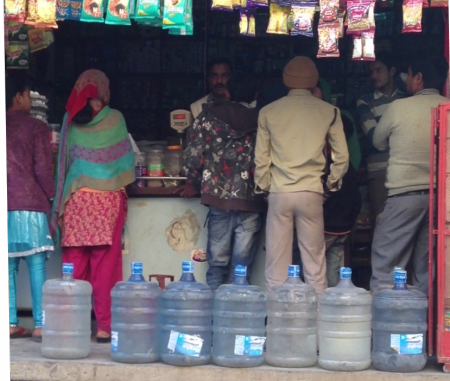- Projects & Programmes
- Business model for clean drinking water using solar RO in Indian industrial belt
Our Portfolio
Business model for clean drinking water using solar RO in Indian industrial belt
The lack of clean, safe drinking water is one of the most acute problems faced by people in developing India. As the population shifts from farming towards working in factories, villages surrounding major towns are being absorbed into the industrial belt. Here, the groundwater has been found to contain high levels of heavy metals and toxins, and water-borne diseases are rampant due to open sewage systems.
Swajal began in 2011 as a survey project assessing water quality in two villages near the towns of Noida and Ghaziabad. People in these villages paid a high price for drinkable water and as a result drank too little water and/or resorted to drinking unclean water. Swajal developed plans for a commercial system based on a solar powered reverse osmosis (RO) water purifier, linked to a chain of small franchised centres which generate clean drinking water and sell it at an affordable price through vending machines.
This project aimed to finalise the Swajal business model, to establish five pilot water purification centres, to set up a central monitoring system supporting the business, and to test its potential for upscaling.

Outcomes
The first stage of the project consisted of surveys to determine the best locations and the most effective design for the pilot system. The project was promoted through workshops and other interactions with local stakeholders such as schools, hospitals and municipalities, and was also widely covered in both print and digital media. Health surveys and educational campaigns were held in schools as well as carried out door-to-door, to teach people about the connection between their health, their medical bills and the quality of their drinking water. Despite local communities being traditionally reluctant to embrace new technology, these campaigns proved very effective and convinced significant parts of the communities to start paying for drinking water.
By the end of the project, all five pilot systems were fully operational and were being intensively used by the target population of 1,000 families. The pilot project also created 4 new jobs, and survey data from the catchment areas clearly showed that health care expenditure decreased after people started drinking water from the Swajal units. This success and the effective marketing created a lot of interest for Swajal’s systems with government bodies, NGOs and private enterprises, and when the project finished a few orders had already come in for installations in other parts of India.
One of the main threats to the long-term success of Swajal as a business was found to be the lack of a supportive policy framework for water pricing (water in India is traditionally free or highly subsidised). At the time it appeared that without this or some sort of subsidy or continuing grant support, the company would struggle to survive. In the intervening years, Swajal has won several awards, such as the India Innovation Growth Program award and the Millennium Alliance award. In August 2015 it raised $1,2 million in its Series A funding round, and a $500,000 R&D project with the Ministry of New and Renewable Energy is also underway. By July 2016, over 50 Swajal water installations were in operation.
